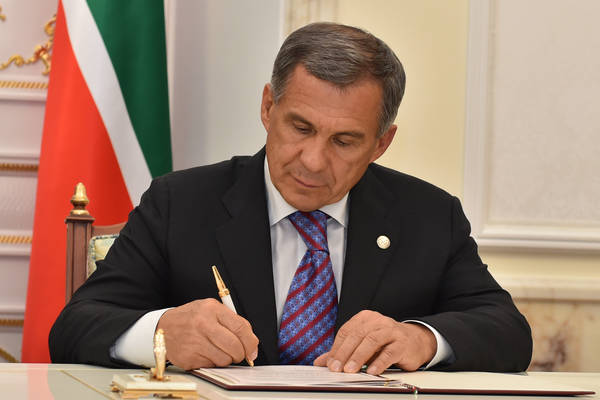
Is the Middle Volga About to Become a Second North Caucasus?
Publication: Eurasia Daily Monitor Volume: 12 Issue: 185
By:

For the last several years, numerous Russian politicians, commentators and activists have repeatedly suggested that the ethnic and religious situation in Russia’s Middle Volga region—which includes the republics of Tatarstan, Bashkortostan, Chuvashia, Mordvinia, Mari El and Udmurtia—is rapidly deteriorating. And they have argued that as a result, the region, long one of the most quiescent of the Russia’s non-Russian portions, is on its way to becoming a second North Caucasus.
An article this week by Rais Suleymanov, who has been the source of many such stories and who is widely viewed by Muslims and Tatars as a provocateur, is typical. He suggests that the Taliban and the Islamic State are now recruiting actively in the Middle Volga and setting the region’s indigenous Muslim population against the Russians with explosive consequences for both. And he urges, as he has before, that Moscow must take harsh measures not only against the population of the Middle Volga but also against the leaders of the republics there who, he says, are protecting the radicals or even promoting their growth (APN, October 8).
The Middle Volga’s overall population numbers more than 25 million. The region sits astride all the communications and transportation links between European Russia and Siberia, and it is the location of much of the country’s oil and natural gas reserves. Therefore, given Moscow’s current ideological concerns and taking into account the Middle Volga’s size as well as geographic and economic importance, it is not surprising that articles like Suleymanov’s inevitably attract so much attention in Russia. Were things to go in the direction he suggests, that development would represent a far greater challenge to Moscow than even the North Caucasus has demonstrated. And considering the fears of what that might mean, many have extrapolated from any ethnic or religious problems there to predict an apocalypse, certain that they will have an audience for such suggestions and that they will not be held to the same standards of evidence that might be required from others about other parts of the Russian Federation.
But such projections almost certainly are overblown or at least misdirected, given the reasons why so many Russians and others accept them. Specifically, these projections are alarmist precisely because the region is so central and therefore the object of tight control by Moscow. Moreover, the Middle Volga has for centuries been deliberately Russified and is located far from the Russian Federation’s external borders. For all these reasons, it is extremely unlikely that the region’s security situation is nearly as dire as Suleymanov and those who think as he does now suggest. Igor Barinov, the head of the new Federal Agency for Nationality Affairs, argued last week that the situation in Tatarstan, the largest and most politically important or the Middle Volga republics, is “one of the best in Russia” and that the authorities there have things well in hand (Nazaccent.ru, October 9).
At a meeting in Bolgar, on October 8, Barinov argued that “in Tatarstan, there is one of the best regional programs for strengthening the unity of the Russian nation and the ethno-cultural development of the peoples of Russia.” He also suggested that other regions in the Russian Federation should learn from Kazan’s actions. To that end, the Russian nationalities official signed a cooperation accord with Tatarstan’s President Rustam Minnikhanov.
While in Tatarstan, Barinov also took part in a Tatar conference entitled, “Muslim Theological Thought: National, Regional and Civilizational Dimensions.” He spoke approvingly about the opening of the Bulgar Islamic Academy and stressed that the measures Tatarstan’s Muslims were taking must be directed at responding to any radical or extremist ideology. He noted that there had been 50 extremist crimes in Tatarstan in 2014, but that 87.8 percent of the republic’s population said that inter-ethnic and inter-religious relations were good—a view that never finds expression in the works of those like Suleymanov.
It is clear that the Middle Volga does pose a challenge to Moscow and perhaps an increasing one. But it comes from an entirely different direction than what those like Suleymanov suggest. It is not so much ethnic or religious radicalism that is at issue, as has been the case in the North Caucasus since Moscow launched its wars against Chechnya. Instead, it is the demand of the leaders of the republics of the Middle Volga—especially those of Tatarstan—for greater autonomy and control. Those demands receive less attention than do the claims of radicals, but they are often more effective.
Tatarstan, despite having had to give up many of the attributes of sovereignty over the last decade, is the only republic in the Russian Federation that still has a “president,” a status that Vladimir Putin himself has recognized as being an issue for the people of Tatarstan to decide. That is real power, as is the fact that Tatarstan controls a larger share of its resources than do most other non-Russian republics; and its officials often rise to positions of power in Moscow itself. Given the hyper-centralization of Putin’s Russia, that kind of power is a far more real threat to Moscow than the supposed Islamic State and Taliban hordes in the region that do not, in fact, exist.




